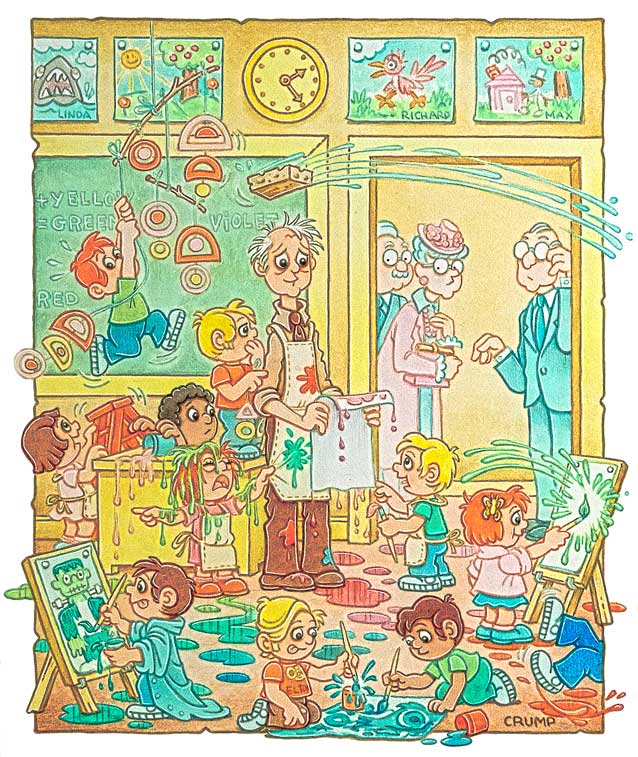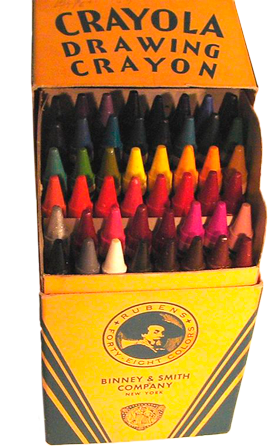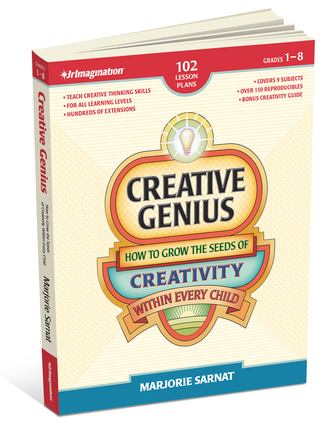Wishing You a Season of Fun and a Happy New Year of Ideas
 Wednesday, December 18, 2013 at 4:00AM |
Wednesday, December 18, 2013 at 4:00AM |  Marjorie Sarnat
Marjorie Sarnat  “See what happens when we run out of crayons?” Illustration by Fred Crump Jr.When we think of the holidays we can't help but have visions of sugarplums and toys. Some toys have endured along with our traditions.
“See what happens when we run out of crayons?” Illustration by Fred Crump Jr.When we think of the holidays we can't help but have visions of sugarplums and toys. Some toys have endured along with our traditions.
These toys are classics that generations have, and continue to, grow-up with. These playthings have a universal appeal that satisfies something within us, young and not-so-young.
It was creative thinkers who gave them life.
A Doll with a Dream
As Ruth Handler watched her daughter, Barbara, play with paper dolls, she observed that Barbara gave them adult roles as she dreamed of her own future.
Back then dolls represented babies and little girls. Discovering a gap in the market, Ruth mentioned the idea of an attractive grown-up doll to her husband, Elliot, who was co-founder of the new Mattel Toy Company.
Mattel believed in the idea and began development of a doll they named Barbie, after the Handlers’ daughter. She made her debut at the American International Toy Fair in New York in 1959. The Barbie Doll is now a cultural icon and remains a best selling toy.
Ruth Handler had taken a commonplace doll, which had been around for centuries, and adapted it to meet a need.
Believe In Your Creative Imagination
“We didn’t know how to run a business, but we had dreams and talent”
– Ruth Handler
Creative Play: Barbie prompts imaginative play-acting and story development. She also inspires original fashion designing.
 Photograph by Fir0002/Flagstaffotos, courtesy WikimediaLose a Job, Find a Fortune
Photograph by Fir0002/Flagstaffotos, courtesy WikimediaLose a Job, Find a Fortune
After losing his job during The Great Depression, Charles Darrow had time on his hands.
He saw his neighbors playing a home-made board game that was gaining interest around the country, in which the object was to buy and sell property. Darrow decided to make and sell some of those games himself, with the help of his family.
Their first sets were made on canvas. Charles drew the designs of the properties with drafting pens, and his son and wife made the cards and painted in the spaces. Darrow hired an artist to draw the now-famous icons and designs such as the red arrow and lettering for “Go.”
He wrote his own version of the rules and secured a copyright for the game in 1933. He began selling copies printed on cardboard to department stores. When he showed his game to Parker Brothers, a game publisher, they rejected it for "52 fundamental errors.”
But when the game’s popularity grew, Parker Brothers reconsidered and signed a contract with Darrow. Within a year, 20,000 sets of the game were being produced every week. Monopoly became the best-selling board game in America, and it made Darrow the first millionaire game designer in history.
Charles Darrow saw big possibilities in a game idea that others saw as only a pass-time.
Value Ideas and Don't Give Up
Held in the palms of thousands of people over the years have been ideas worth millions – if they only had taken the first step and followed through.
Creative Play: Monopoly requires elaboration of plans, flexibility in strategies, and original ideas to negotiate staying in the game.
 Photograph By Kurt Baty (Own work) [CC-BY-SA-3.0], via Wikimedia CommonsThe Birth of 8 Great Brainchildren
Photograph By Kurt Baty (Own work) [CC-BY-SA-3.0], via Wikimedia CommonsThe Birth of 8 Great Brainchildren
In 1885, Edwin Binney and C. Harold Smith formed the Binney & Smith Company. Their product line included slate pencils for schools, which prompted them to research non-toxic and more colorful drawing mediums for kids. They had already invented wax crayons for marking crates, but these were unsafe for children. Binney and Smith believed that their pigment and wax mixing techniques could be adapted for a range of safe colors.
In 1903 a box of eight crayons that were non-toxic and had superior coloring qualities was introduced to school kids everywhere: Crayolas. Crayons have been helping kids express creative ideas ever since.
Explore New Points of View
Binney & Smith took an established item, industrial crayons, and re-imagined them for school kids.
Creative Play: Crayons have been the foundation of millions of childhood artworks, drawings of ideas, illustrated stories, creative activities, and all kinds of original works—way too numerous to list here.
*
Fred & Me and Binney & Smith
Perhaps one the kids who loved to draw with crayons was young Fred Crump, Jr. on his way to becoming an inspiring teacher and a world class artist and author.
I crossed paths with him early in my career when I was the editor of an art education magazine, Arts & Activities. Somehow an art teacher named Fred Crump sent me one of his amazing illustrations. I published it as a caption contest with a cash prize. The winner was a sales rep for Binney & Smith, with: “See what happens when we run out of crayons?” But the best prize of all: Mr. Crump let me keep his illustration, which I have framed and cherished ever since.
Creative Mr. Crump
Fred Crump, Jr., 1931-2005, taught art at a junior high school for 32 years. After retiring, he pursued a career as an author and illustrator of children’s books and stories. Mr. Crump brought the fairy tales of childhood to African-American kids in a way they could personally connect with. He devoted the rest of his life to retelling popular children’s stories, many tales from Africa, for African-American audiences.
One of his students remembered:
“When you walked into his art classroom, it was as if you had just walked into a life sized comic strip. Giant full color paper mache statues [of comic characters] lined the classroom, almost like statues of Greek gods. It was quite an environment! He introduced us to TONS of art in that class. From studying classic painters like Monet and Rembrandt to learning clay sculpture. All in 7th grade!!! " And he reminded his students to always have a sharpened pencil on hand.
More memories about Mr. Crump can be found here.
In honor of our toy inventors and author-artist Fred Crump, Jr., and in the spirit of a fun holiday season, ask your kids to invent their own toys. Who knows? They could become classics for Christmases yet to come! Enjoy your holidays and have a Happy New Year.
Invent-a-Toy
If you can't always provide dream toys for your kids, you can have even more fun with them by inventing your own toys together. Imagine a new and different version of an ordinary toy they already have. For example, an upgraded teddy bear could change color by touch, it could sing and dance, tell bedtime stories, or have secret hiding pockets. It could become a giant sleeping bag, inspire jewelry, or hold a paintbrush that paint real pictures.
Dream it, plan it, and sketch it along with your kids. Perhaps one day it'll appear on the shelves of a toy store chain!
We have a stand-alone 12 page lesson plan, "Invent-a Toy" available in our Teachers Pay Teachers store.
 Charles Darrow,
Charles Darrow,  Crayola crayons,
Crayola crayons,  Fred Crump Jr,
Fred Crump Jr,  Ruth Handler,
Ruth Handler,  inventing,
inventing,  toys
toys 


